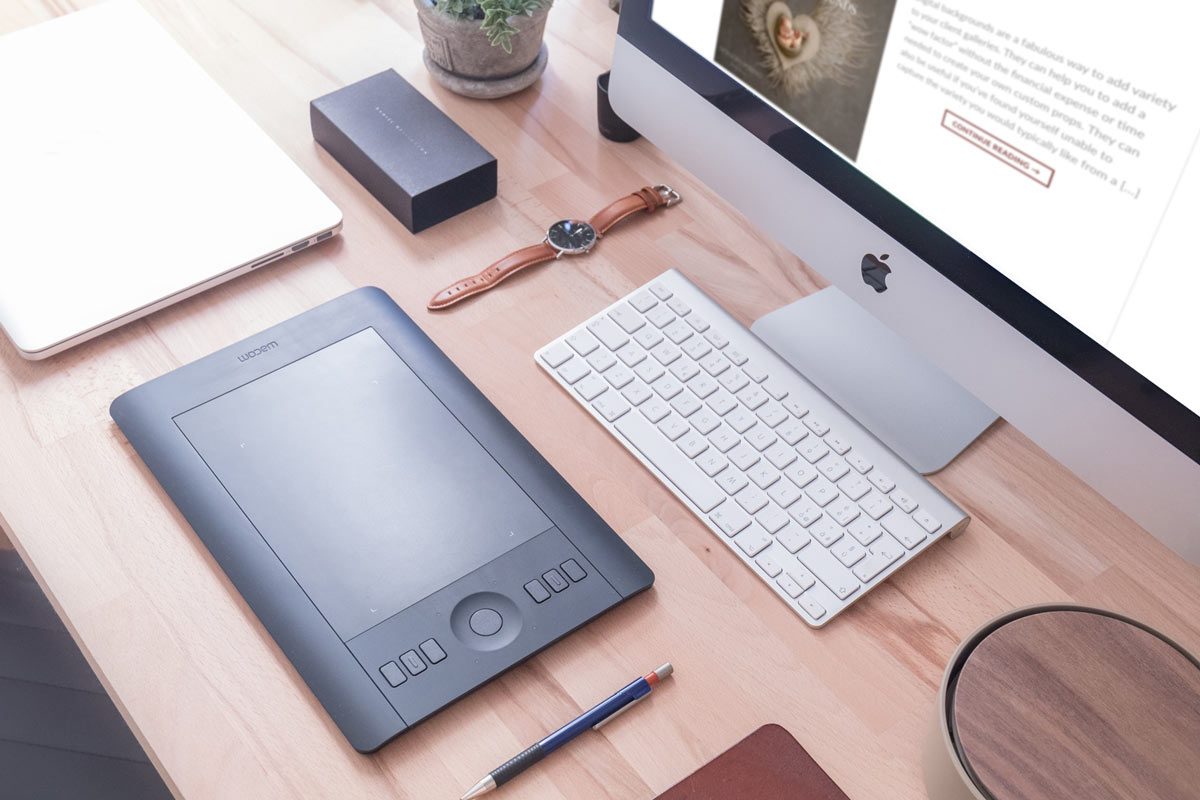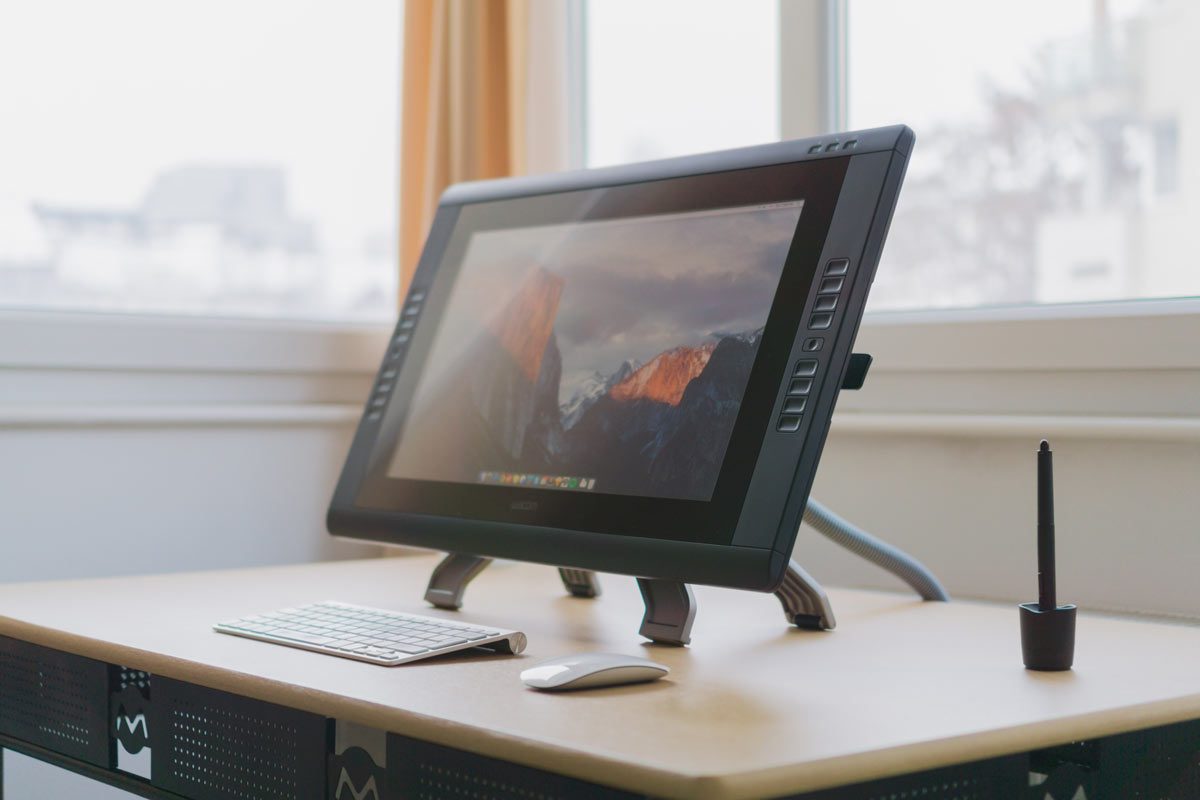For many photographers and digital artists, a graphics tablet is an indispensable tool. It opens up endless creative possibilities and enables greater accuracy and speed than conventional input devices.
We make no secret of the fact that we love Wacom tablets here in the studio. Many of us have been using them for decades, long before we even met each other!

WHAT EXACTLY IS A GRAPHICS TABLET?
A graphics tablet is simply an input device for your computer. It’s an alternative to using a mouse or trackpad, allowing you to communicate using a stylus (pen) on an electronic, pressure-sensitive surface (tablet).
The process is similar to drawing with pen on paper. And when you think about it, much more natural than clicking and dragging a puck-shaped device around your desk, constantly repositioning it.
The tablet surface is typically mapped to your screen. For example, holding the stylus in the bottom left corner of the tablet will place your on-screen cursor in the bottom left corner of your display.
GRAPHICS TABLET? DRAWING TABLET? PEN DISPLAY? PEN COMPUTER? WHICH IS WHICH?!
The terms are sometimes used interchangeably, however, “graphics tablet” is commonly used generically for a tablet and stylus input device. (Some people make the distinction between a graphics tablet having an opaque surface, versus a drawing tablet having a digital display surface.)
A standard graphics tablet, such as a Wacom Intuos series, requires you to draw with the stylus on the opaque tablet surface, whilst watching the cursor move on your computer display. These are also referred to as Pen Tablets by Wacom.
However, a tablet which features a digital display, such as a Wacom Cintiq series (or simply an iPad) allows you to draw directly on the image displayed on the tablet surface. They carry a significantly higher cost than a standard pen tablet. There are multiple options to explore. These include those which are simply an input device to be attached to a computer, while others are a standalone drawing tablet complete with operating system onto which the user installs their own editing/drawing software such as Photoshop. These are also known as Pen Displays and Pen Computers.

COMMON BENEFITS AND FEATURES OF GRAPHICS TABLETS
- Commonly used by photographic retouchers, illustrators, animators and other creatives
- Drawing or moving the cursor with a stylus pen allows greater accuracy than a mouse,
- Tablet detects the level of pressure applied to control brush size, opacity and flow when these options are selected in Photoshop
- Drawing with a stylus can produce smoother, more seamless curves than a mouse
- Draw complex shapes easier than with a mouse
- Allows greater accuracy when retouching intricate areas
- The motion is more natural than using a mouse
- Many models offer wireless Bluetooth connectivity
- Increased productivity
- Not exclusive to creative applications so can be used in web-browsers, word processors and so on, instead of a mouse if you wish
- Many models (eg. Intuos Pro) include customisable shortcut buttons and dials which you can allocate to commonly used tasks to further speed your workflow
- Many models offer a range of styluses and nibs to suit your needs as an artist
WHICH GRAPHICS TABLET IS RIGHT FOR YOU?
It’s safe to say that Wacom is the long-standing industry standard for graphics tablets for photographers, illustrators and animators, having been a reputable name since the 1980s.
They offer many models, ranging from entry-level doodlers and notetakers (see SmartPads/Bamboo), to the Intuos and Intuos Pro series commonly used by enthusiast and professional photographers, as well as the higher-end pen-displays / pen-computers with the Cintiq range for those wanting extra mobility.
Intuos versus Intuos Pro?
One of the key differences between the Pro and non-Pro models, other than size options, is the pen sensitivity. The Pro tablet and stylus has twice as many pen pressure levels as the non-pro, so based on that sensitivity and response, the IntuosPro series is a firm choice for many of us in the studio. We’ve found them an invaluable investment throughout our careers.
The Cintiq series are beautiful looking tablets, offering versatility in the way you work and a new level of mobility. Again, as with the Intuos range, they take some getting used to as the feel is a little different again. There is quite a jump in price up to the Cintiq range so we recommend getting in touch with your local retailer for a demonstration if you feel this could be a worthwhile investment for your business.
IS A GRAPHICS TABLET DIFFICULT TO USE?
For some users, the biggest hurdle is often having to forget the learned “click, drag, reposition and repeat” process they went through the first time they used a computer mouse. (I’ve seen a young child who’d never used a mouse before, comfortably using a graphics tablet in just minutes – because, I suspect, she didn’t have that behaviour to unlearn.) It does take a little persistence to retrain yourself, however, if you can hold a pen, you can use a graphics tablet.
You may find it takes 3 or so days of practice to become comfortable with the process. And… you might also decide you’ve had enough after 5 minutes, (many, many people do initially, including some of us in the studio). But stick with it. It does feel different, but the benefits of speed, skill and accuracy are well worth it.
HINT: Disconnect your mouse and store it in a separate part of the office/house. Set yourself a period of time (at least a few hours) to train with the tablet before allowing yourself to return to your mouse. Ideally, don’t start this process during a busy editing period. Give yourself time to become comfortable with the technique.

DO I NEED DRAWING OR ILLUSTRATION SKILLS?
No.
In fact, many users who feel they’ve never had strong drawing skills report that the techniques they develop through the use of a graphics tablet have helped them with their hand drawing skills. For others, it offers a different medium for artistic expression to those they tried and perhaps not had success with in the past.
OUR EXPERIENCE
Kelly Brown has been using Wacom Intuos tablets for over a decade. She prefers the medium size whether working with her laptop, or with her 2 display (monitor and iMac) setup. Because the Wacom tablets last so well, when Kelly upgrades to a new model, her older tablet moves to her home office while the newer one comes to her studio office. The speed and accuracy gained from working with a Wacom graphics tablet make it a fantastic investment for any photographer.


Kirsty Faulkner says
I have a Wacom and really love it, however, I’d LOVE to know how Kelly has set up her pen – its quite difficult to know all the different settings etc, and it would be wonderful to have some insight into the way she uses hers! <3 xx
André Glasbergen says
Is it handy to use with lightroom?
Wilma says
I am really interessed, but i use Lightroom instate of photoshop. Is it still handy for that?
Alan says
Hi I am just in the process of moving to a tablet. I keep going to buy it but then backing away as it’s yet another learning curve to ad to digital photography and photoshop etc ??????